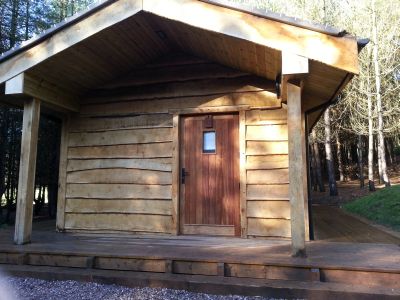Timber Construction : The upside and downside of timber based construction
The upside and downside of timber based construction
When considering constructing a building that's timber cladded or framed, it's a good idea to consider the pros and cons of what timber offers compared with some alternatives out there. The final decision of what to use for the construction of a building should be based on the specific project requirements which include factors such as location and availability of materials.
Speed of construction
It is generally accepted that when using wooden framing that has been pre-made before construction begins, the building process is generally much quicker than a traditional construction based around bricks and blocks. This is due to the fact that a timber frame can usually be made on site by the supplying company's own carpenters. A typical timeframe for this type of construction is 7 to 10 working days after arrival.

The finishing of a house isn't based around construction times alone though. For tradesmen like electricians and carpenters to get in and carry out of their work, a building needs to be sealed from the elements. This impacts a wide range of jobs such as laying oak flooring which is essential to the inside of a house, to wall painting, this sort of work can be carried out much sooner when using timber, meaning that the overall finishing time of a house can be sped up greatly. Even if further brickwork is needed on the outside of a house, this can be carried out once the wooden shell has been constructed and made watertight, further cutting down on completion times.
Construction quality and ease of a timber based building
One of the most straight forward aspects of building a wooden framed house is actually erecting the frame itself. To ensure a high quality construction is completed, typically manufacturers need to take charge to ensure that the exact construction plans and specifications are met. This can be a downside as more contractors need to be on site but for getting something as crucial as the correct positioning of things like oak beams, this is probably worth it.
The thermal properties of wood
In general wood is an excellent insulator which makes it perfect for house construction. Having a material that is able to insulate so well located deep within a structure makes timber the perfect building material as it allows for thinner walls that still have the same insulation properties as houses constructed with pure masonry with thicker walls.
Another significant difference between an all masonry building and one with timber walls is the difference in heat retention of the materials. Masonry typically has to be heated up from cold in order to produce a good room temperature, this heat absorbing property typically consumes a lot more energy than wooden walls which do not require this warming in order to produce a warm room. Therefore, timber can drastically save on heating costs.
Sound and audio insulation properties
If sound is a major concern for you when building a house then masonry does have the slight edge here. In order to block noise, it is common to rely on putting something dense and solid around the source in order to contain the sound-waves. As masonry is the denser of the two materials, it does have better sound blocking properties.
Timber shouldn't be written off too soon though. The same level of noise dampening can be achieved when using timber too with the correct construction principles. A gap can be created between two layers of wood and filled with a sound dampening, noise absorbent material which can actually perform it's function far better than a solid brick wall.
Overall
Both the upsides and downsides of these two methods of construction need to be considered as a whole. Timber does have a significant advantage over masonry in a number of areas, however things such as cost and material availability will naturally play a role in the decision making process.







 Main Menu
Main Menu

